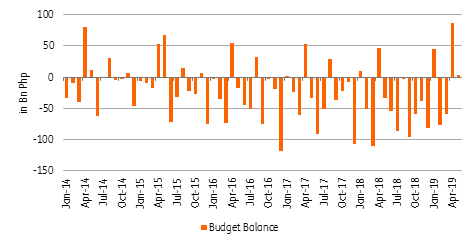Philippines posts budget surplus in May with spending held back
The surplus helped cut the year-to-date deficit to -Php809 million, narrower than the Php138.7 billion deficit in the first five months of 2018
YTD Budget balance at -Php809mn
After holding back 1Q GDP growth, the ill effects of the budget delay appear to have seeped into 2Q, with the May budget surplus hitting Php2.6 billion. Revenue collection continued to rise, up 23% year-on-year while spending grew 7.8% largely due to the final tranche of the government pay bump. For the year so far, the Philippines has posted a deficit of Php809 million, much narrower than the Php138.7 billion deficit posted in the first five months of 2018, as government spending has been reined in.
Philippine budget balance in billion PHP

Government spending on hold could mean lacklustre 2Q GDP
With government spending curtailed for most of the current quarter, the government is scrambling to implement “catch up” spending for the second half of the year. The month of May has been a deficit month for the last three years, with the economy getting a nice boost from the government to complement mainstay household consumption growth. With capital formation still likely to post lacklustre numbers- as evidenced by anaemic car sales and weaker imports of capital goods and raw materials, 2Q GDP will likely need to lean heavily on household consumption yet again.
Data dependent BSP watching
Bangko Sentral ng Pilipinas (BSP) has vowed to remain data dependent and will likely be monitoring variables related to inflation and maybe even growth. Minutes of the May policy meeting show that members took the startlingly low 1Q GDP print into consideration when they cut policy rates by 25 basis points to reverse BSP’s ultra-aggressive rate hike in 2018. The next Monetary Board meeting coincides with the release of 2Q GDP and given the prospects for within-target inflation, and growth hampered by both relatively high borrowing costs and delayed spending, we could see the monetary authorities trimming borrowing costs further in 3Q.
This publication has been prepared by ING solely for information purposes irrespective of a particular user's means, financial situation or investment objectives. The information does not constitute investment recommendation, and nor is it investment, legal or tax advice or an offer or solicitation to purchase or sell any financial instrument. Read more
Tags
PhilippinesDownload
Download snap
25 June 2019
Good MornING Asia - 26 June 2019 This bundle contains 2 Articles